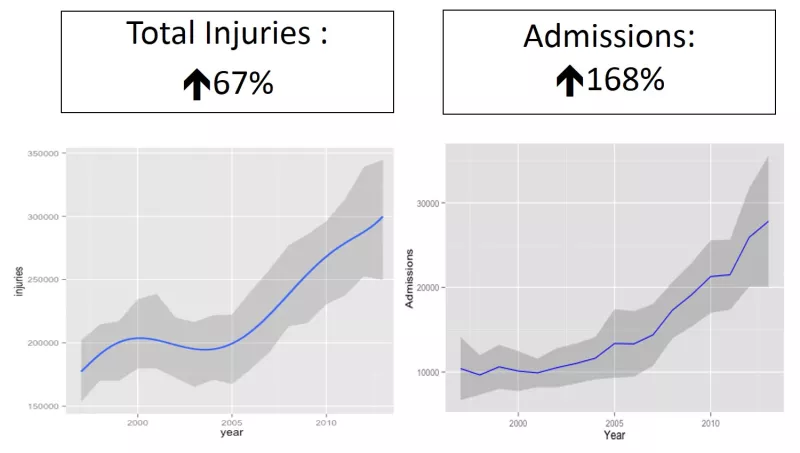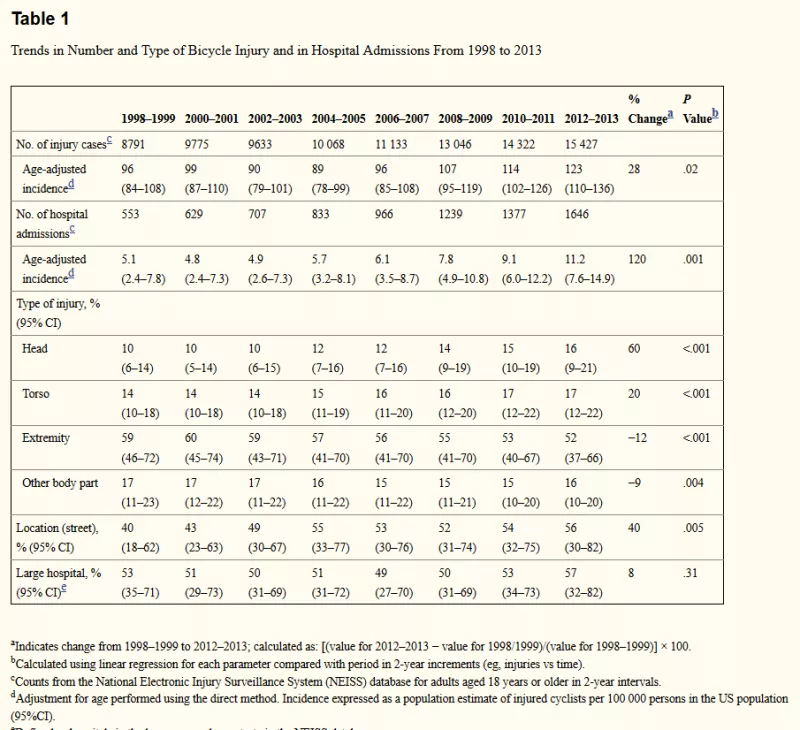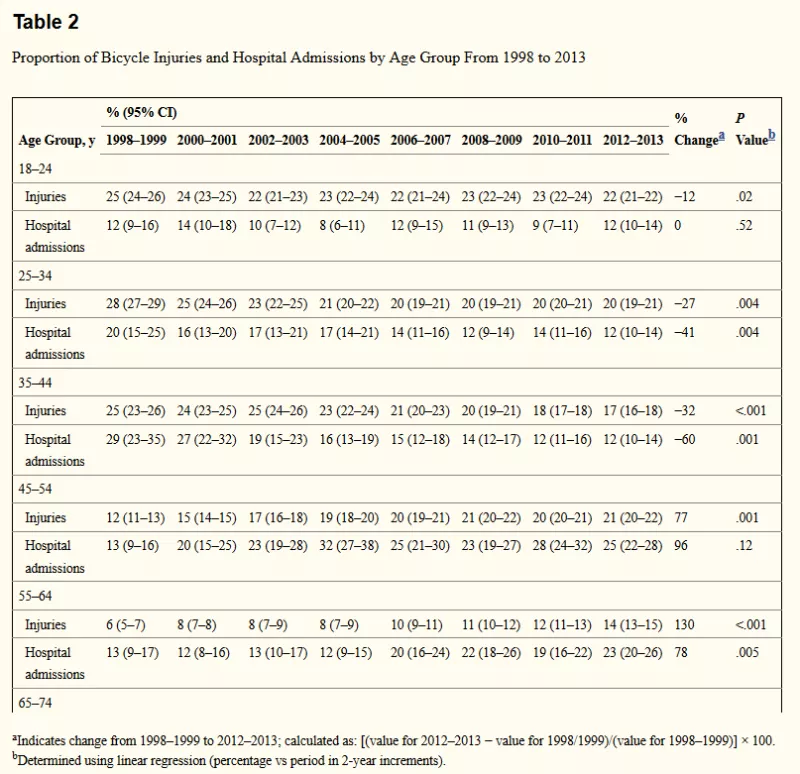Bicycle Trauma Injuries and Hospital Admissions in the United States, 1998–2013 (PDF)
JAMA. 2015 Sep 1; 314(9): 947–949.
Background: Cycling is associated with many health benefits, but also with the risk of injury. Trends in bicycle-related injuries are difficult to assess because the majority of nonfatal injuries sustained while cycling are not reported to police and thus are not included in traffic statistics.1 We sought to evaluate trends in adult cycling injuries and hospital admissions in the United States using emergency department data.
Methods: The National Electronic Injury Surveillance System (NEISS) is a national probability sample of approximately 100 emergency departments that gathers product-related injury data.2 We queried the NEISS for injuries associated with bicycles (codes 5033 and 5040) from 1998 to 2013. The University of California, San Francisco, institutional review board gave the study exempt status.
The number of bicycle-related injuries in adults aged 18 years or older was recorded in 2-year intervals. We used the NEISS complex sample design to calculate population projections of cycling-related injuries, which were then divided by US Census data to produce incidence per 100 000 persons. Adjustment for age was performed using the direct method. Linear regression was used to evaluate trends in injuries and hospital admissions vs time (2-year intervals) for the entire sample as well as for the proportion of injuries by specific age groups. We also calculated the ratio of injuries by body part, location (street vs nonstreet), and hospital size.
Hospital size was used as a proxy for urban vs rural location given large hospitals were located in urban areas in the NEISS database. Statistical analysis was performed using R version 3.1.1 (R Project for Statistical Computing). P values <.05 (2-sided) were considered significant.
Results: Trends in the incidence of injuries and hospital admissions are summarized in Table 1. During the study period, the 2-year age-adjusted incidence of injuries increased by 28% from 96 (95% CI, 84–108) to 123 (95% CI, 110–136) per 100 000 (P = .02) and the 2-year age-adjusted incidence of hospital admissions increased by 120% from 5.1 (95% CI, 2.4–7.8) to 11.2 (95% CI, 7.6–14.9) per 100 000 (P = .001).
When evaluated by injury type, the percentage of injured cyclists with head injuries increased from 10% (95% CI, 6%–14%) to 16%(95% CI, 9%–21%) (P < .001) and torso injuries increased from 14% (95% CI, 10%–18%) to 17% (95% CI, 12%–22%) (P < .001). The percentage of injuries occurring on the street increased over time from40%(95% CI, 18%–62%) to 56% (95% CI, 30%–82%) (P = .005).
There was no significant change in the proportion of injured patients presenting to large hospitals. Overall, 35% of injuries occurred in women and there was no significant change in sex ratio over time.
Changes in the proportion of injuries occurring within specific age groups are summarized in Table 2. The proportion of injuries occurring in individuals older than 45 years increased 81% from 23% (95% CI, 20%–26%) to 42% (95% CI, 39%–45%) (P < .001) and the proportion of hospital admissions in individuals older than 45 years increased 66% from 39% (95% CI, 25%–53%) to 65%(95% CI, 55%–75%) (P < .001).
Discussion: This study reports an increase in bicycle-related injuries and hospital admissions in adults in the United States between 1998 and 2013. The increase in overall injuries was driven by an increase in injuries in individuals older than45 years. The increase in hospital admissions outpaced the increase in overall injuries, perhaps due to an increase in severe injuries in older individuals,3 who made up a greater proportion of injured cyclists in 2012–2013 compared with 1998–1999. These injury trends likely reflect the trends in overall bicycle ridership in the United States in which multiple sources show an increase in ridership in adults older than 45 years.4,5
Other possible factors contributing to the increase in overall injuries and hospital admissions include an increase in street accidents4 and an increase in sport cycling associated with faster speeds.6 As the population of cyclists in the United States shifts to an older demographic, further investments in infrastructure and promotion of safe riding practices are needed to protect bicyclists from injury.



